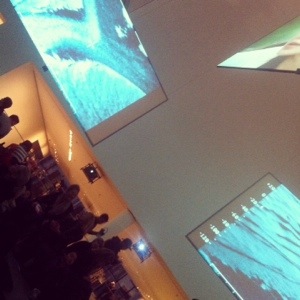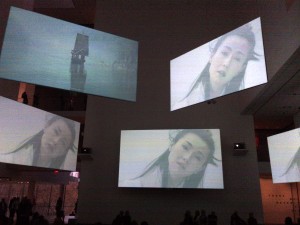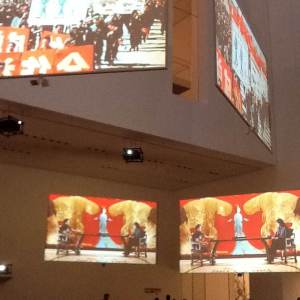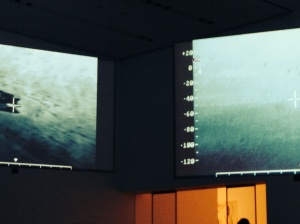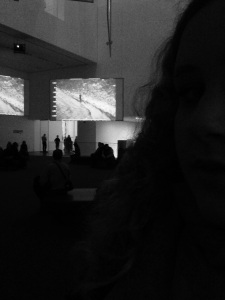After spending the full 50+ minutes lying underneath the screens of Isaac Julien’s Ten Thousand Waves, I left feeling as though I’d gone through an all-encompassing screen experience unlike any screen-based experience I’d had prior. Once I realized that seeing the entirety of the piece at once was absolutely impossible while in the center of the installation, I relaxed and allowed the images to float over me, akin to the shots he included of waves and people floating in a river.
The installation deals with Chinese identity and the cultural shift from communism to capitalism. Many of the screens were filled with gorgeous images of Chinese capitalism, but a critique was always implicit (and often explicit). Many of the gestures were absolutely gorgeous; a man painting Chinese calligraphy on a pane of glass becomes a painting the second the man steps out of the frame. For one moment we are allowed to experience the image as a painting, followed immediately by hired laborers who clean the glass; a jarring insertion of capitalist toil and values against an otherwise pristine, sparse, traditionally Chinese medium.
The rhythm of the piece, as well as it’s all encompassing sonic and visual nature, allowed it to strike a balance between pseudo-zen moments of relaxation and release and the more high-intensity, dense, overwhelming sounds and images of modern day China. A great deal of the work seemed to deal with the loneliness of opulence; images of happy, fierce looking Communist legions are juxtaposed (and played simultaneously) with sparse, luxurious images with one woman, perpetually unhappy, surrounded by wealth but seeming to lack any interior fulfillment.
I couldn’t help but read into the sort of “making-of” shots as a very Brechtian gesture, “bearing the device” of the construction of the shots in order to remove the viewer from the captivation of their imagery. This self-reflexive gesture allowed the viewer to see inside the inner workings of the film and how it was constructed; the female “spirit of China” draped in white traditional garb once flowed through downtown Hong Kong gracefully, but we see her surrounded by a green screen and it becomes evident that she has been made iconic, made into something she is not, reminding the viewer that this is not just a simple narrative but a construction of the artist’s intent. Shots of the luxuriously wealthy capitalist woman riding a streetcar seem haphazard at first, but when we see the large camera crews, the production company scurrying about, and the tracking shots as they are being filmed, the viewer is once again reminded that this false narrative is just that: false, constructed.
These gestures did not remove me from the emotional freight of the work; for the entirety of my time spent there I was a captive viewer, engaged in all of the material present, attempting to draw connections between the various images he put forth and the screen-mounted sound environment he was able to produce. In the end it seemed an appropriate embrace of Chinese culture, and a simultaneous, scathing (if seductive and compelling) critique of consumer culture in China. The “moments of relaxation” he offered up, reminders of our temporal, metaphysical reality, were perhaps some of the most effective uses of space and sound for me, and for the duration of those moments I felt myself also adrift in the rivers of time (as cheesy as that might sound, it was an absolutely remarkable experience, one that happens all-too-infrequently in engaging with art).
All in all the work was one of my favorite art-experiences to date, incredibly well executed, and critically, aesthetically, spiritually, and emotionally engaging in ways that I’d never thought possible with art-making. His use of the space was the most effective I’ve ever experienced at MoMA, and I walked away from the piece in a contemplative, relaxed, and critical mood that I myself hope to be able to inspire in viewers.
Some favorite quotes:
All dreams are not your dreams. All desires are not your desires.
Worked to death, working to (till?) death.



